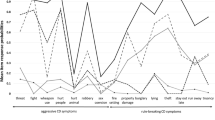Abstract
Is conduct disorder (CD) as defined in the Diagnostic and Statistical Manual of Mental Disorders (DSM-IV; American Psychiatric Association, 1994) a unitary entity, or do variants of CD exist? We addressed this question, using data collected from the parents of 1,669 Australian boys, aged 6–17. Parents were interviewed to assess DSM-IV Conduct Disorder (DSM-IV CD) criteria. Results revealed 2 subfactors of DSM-IV CD symptoms, made up of overt behaviors (e.g., initiating physical fights) and covert behaviors (e.g., stealing without confrontation). Ordinary least squares regressions showed the 2 CD subfactors to be significantly and uniquely predicted by Child Behavior Checklist (CBCL; T. M. Achenbach, 1991a, 1991b) syndromes labeled Aggressive Behavior and Delinquent Behavior, respectively. The results are discussed in terms of the utility of differentiating these 2 variants of CD in future editions of the DSM.
Similar content being viewed by others
REFRENCES
Achenbach, T. M. (1991a. Integrative guide to the 1991 CBCL/4–18, YSR, and TRF profiles. Burlington: University of Vermont, Department of Psychiatry.
Achenbach, T. M. (1991b. Manual for the Child Behavior Checklist/4–18 and 1991 profile: Burlington: VT: University of Vermont, Department of Psychiatry
Achenbach, T. M., & Rescorla, L. A. (2001. Manual for the ASEBA school-age forms and profiles. Burlington: University of Vermont, Research Center for Children, Youth, and Families
American Psychiatric Association. (1968. Diagnostic and statistical manual of mental disorders (2nd ed.. Washington, DC: Author.
American Psychiatric Association. (1980. Diagnostic and statistical manual of mental disorders (3rd ed.. Washington, DC: Author.
American Psychiatric Association. (1987. Diagnostic and statistical manual of mental disorders (3rd ed., rev.. Washington, DC: Author.
American Psychiatric Association. (1994. Diagnostic and statistical manual of mental disorders(4th ed. Washington, DC: Author.
Bird, H. R., Gould, M. S., & Staghezza, B. (1992. Aggregating data from multiple informants in child psychiatry epidemiological research. Journal of the American Academy of Child and Adolescent Psychiatry, 31, 78–85.
DiLalla, L. F., & Gottesman, I. I. (1989. Heterogeneity of causes for delinquency and criminality: Lifespan perspectives. Development and Psychopathology, 1, 339–349.
Edelbrock, C., Rende, R., Plomin, R., & Thompson, L. A. (1995. A twin study of competence and problem behavior in childhood and early adolescence. Journal of Child Psychology and Psychiatry and Allied Disciplines, 36, 775–785.
Frick, P. J., Lahey, B. B., Loeber, R., Stouthamer-Loeber, M., Green, S., Hart, E. L., et al. (1991. Oppositional defiant disorder and conduct disorder in boys: Patterns of behavioral covariation. Journal of Clinical Child Psychology, 20, 202–208.
Frick, P. J., Lahey, B. B., Loeber, R., Tannenbaum, L., Van Horn, Y., Christ, M. A. G., et al. (1993. Oppositional defiant disorder and conduct disorder: A meta-analytic review of factor analyses and cross-validation in a clinic sample. Clinical Psychology Review, 13, 319–340.
Garton, A. F., Zubrick, S. R., & Silburn, S. R. (1995. The Western Australian Child Health Survey: A pilot study. Australian and New Zealand Journal of Psychiatry, 29, 48–57.
Hartman, C. A., Hox, J., Mellenbergh, G. J., Boyle, M. H., Offord, D. R., Racine, Y., et al. (2001. DSM-IV internal construct validity: When a taxonomy meets data. Journal of Child Psychology and Psychiatry and Allied Disciplines, 42, 817–836.
Lahey, B. B., Loeber, R., Quay, H. C., Applegate, B., Shaffer, D., Waldman, I., et al. (1998. Validity of DSM-IV subtypes of conduct disorder based on age of onset. Journal of the American Academy of Child and Adolescent Psychiatry, 37, 435–442.
Lahey, B. B., Waldman, I. D., & McBurnett, K. (1999. The development of antisocial behavior: An integrative causal model. Journal of Child Psychology and Psychiatry and Allied Disciplines, 40, 669–682.
Loeber, R. (1982. The stability of antisocial and delinquent child behavior: A review. Child Development, 53, 1431–1446.
Loeber, R., & Lahey, B. B. (1989. Recommendations for research on disruptive behavior disorders of childhood and adolescence. In B. B. Lahey & A. E. Kazdin (Eds.), Advances in clinical child psychology (Vol. 12, pp. 221–251). New York: Plenum.
Loeber, R., Lahey, B. B., & Thomas, C. (1991. Diagnostic conundrum of oppositional defiant disorder and conduct disorder. Journal of Abnormal Psychology, 100, 379–390.
Loeber, R., & Schmaling, K. B. (1985. Empirical evidence for overt and covert patterns of antisocial conduct problems: A metaanalysis. Journal of Abnormal Child Psychology, 13, 337–352.
Moffitt, T. E. (1993. Adolescence-limited and life-course-persistent antisocial behavior: A developmental taxonomy. Psychological Review, 100, 674–701.
Muthén, L. K. & Muthén, B. O. (1998. Mplus User's Guide. Los Angeles: Author.
Patterson, G. R. (1982. Coercive family process. Eugene, OR: Castalia.
Quay, H. C. (1986. Classification. In H. C. Quay & J. S. Werry (Eds.), Psychological disorders of childhood (pp. 1–34). New York: Wiley.
Rey, J. M., Bashir, M. R., Schwarz, M., Richards, I. N., Plapp, J. M. & Stewart, G. W. (1988. Oppositional disorder: Fact or fiction? Journal of the American Academy of Child and Adolescent Psychiatry, 27, 157–162.
Rey, J. M., & Morris-Yates, A. (1993. Are oppositional and conduct disorders of adolescents separate conditions? Australian and New Zealand Journal of Psychiatry, 27, 281–287.
Sawyer, M. G., Kosky, R. J., Graetz, B. W., Arney, F., Zubrick, S. R. & Bagshurst, P. (2000. National Survey of Mental Health and Well-Being: Child and adolescent component. Australia and New Zealand Journal of Psychiatry, 34, 214–220.
Schmitz, S., Fulker, D. W., & Mrazek, D. A. (1995. Problem behavior in early and middle childhood: An initial behavior genetic analysis. Journal of Child Psychology and Psychiatry and Allied Disciplines, 36, 1443–1458.
Shaffer, D., Fisher, P., Lucas, C. P., Dulcan, M. K., & Schwab-Stone, M. E. (2000. NIMH Diagnostic Interview Schedule for Children Version IV (NIMH DISC-IV): Description, differences from previous versions, and reliability of some common diagnoses. Journal of the American Academy of Child and Adolescent Psychiatry, 39, 28–38.
Author information
Authors and Affiliations
Corresponding author
Rights and permissions
About this article
Cite this article
Tackett, J.L., Krueger, R.F., Sawyer, M.G. et al. Subfactors of DSM-IV Conduct Disorder: Evidence and Connections with Syndromes from the Child Behavior Checklist. J Abnorm Child Psychol 31, 647–654 (2003). https://doi.org/10.1023/A:1026214324287
Issue Date:
DOI: https://doi.org/10.1023/A:1026214324287




